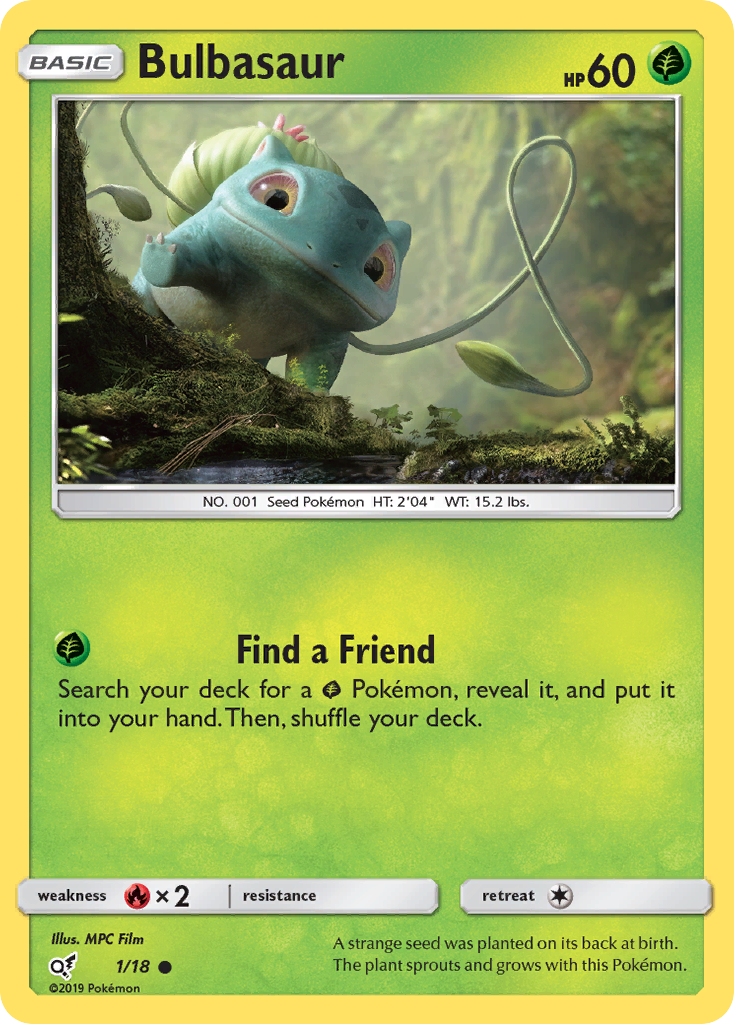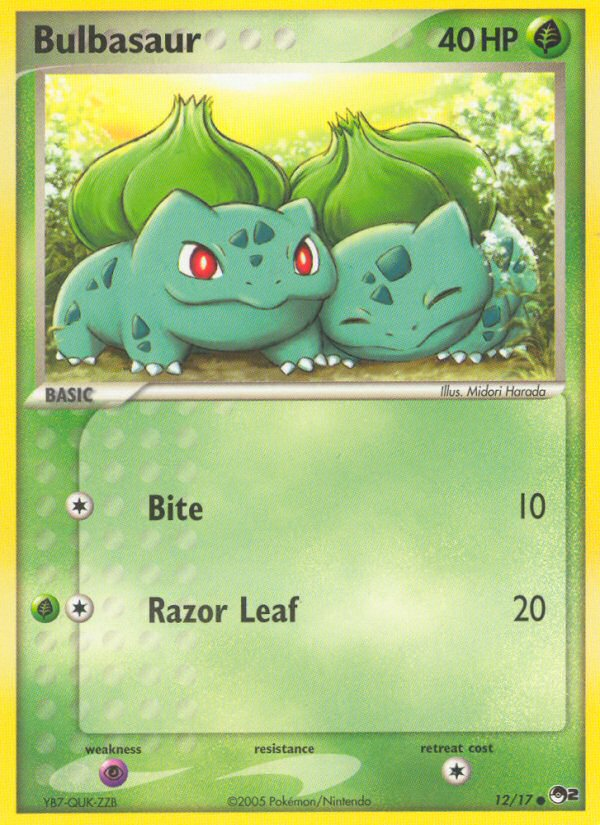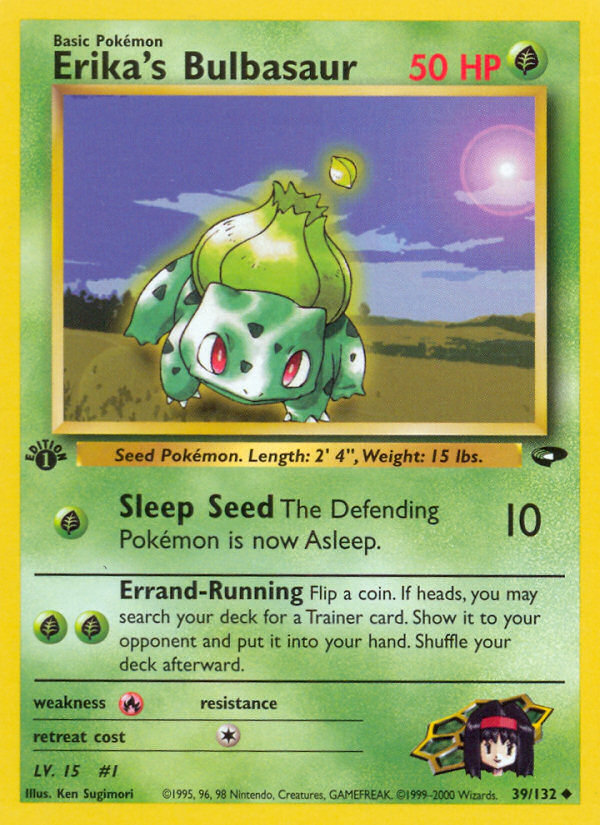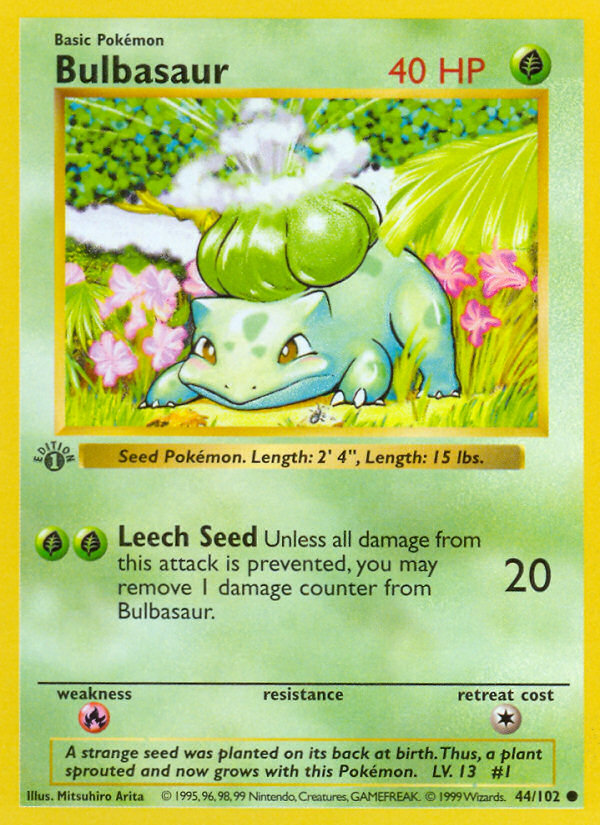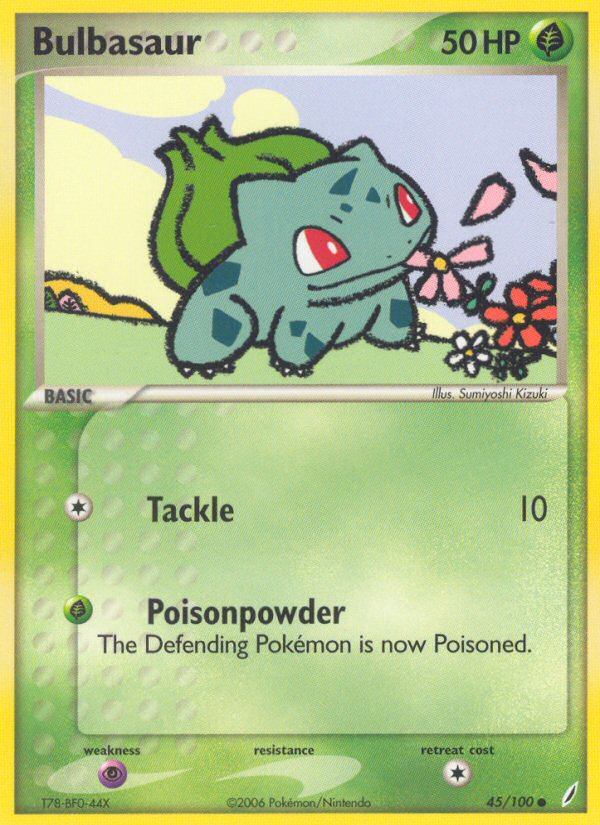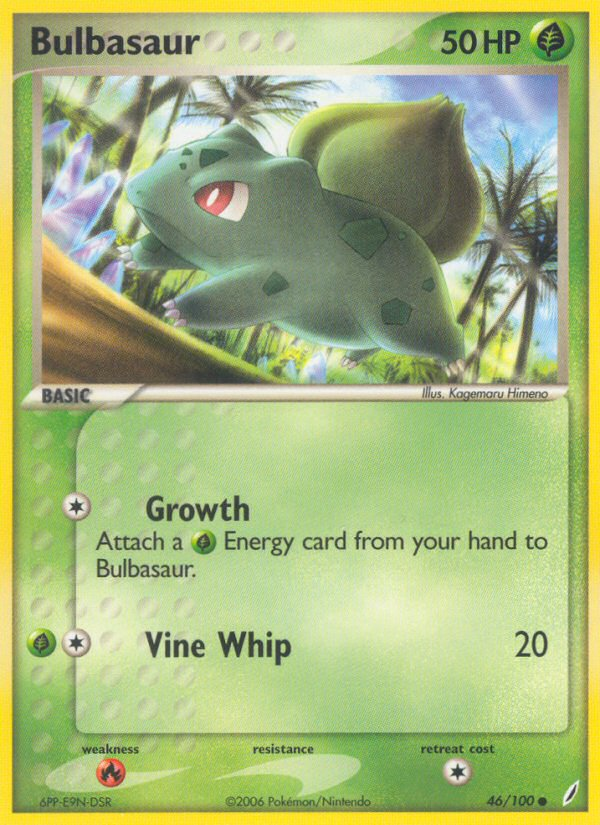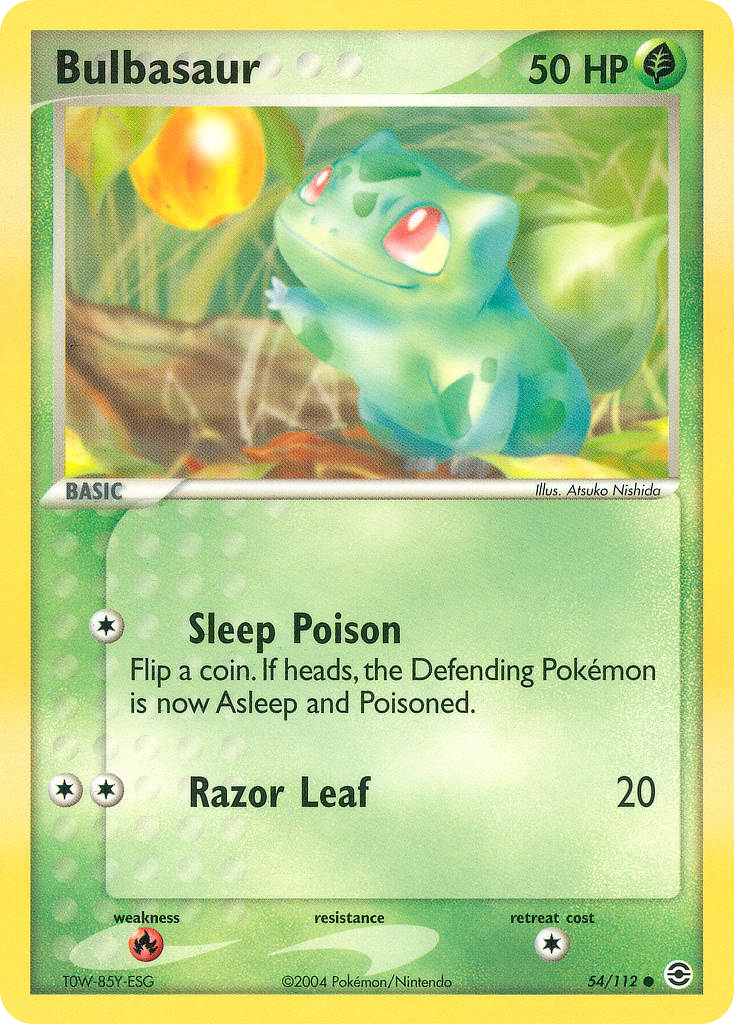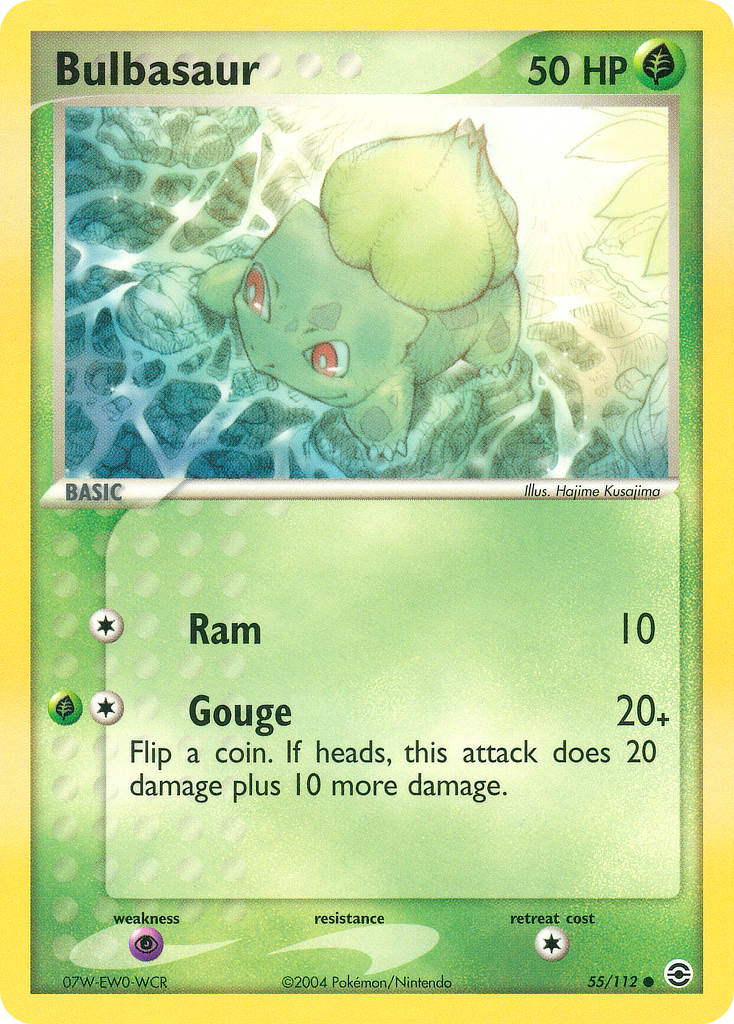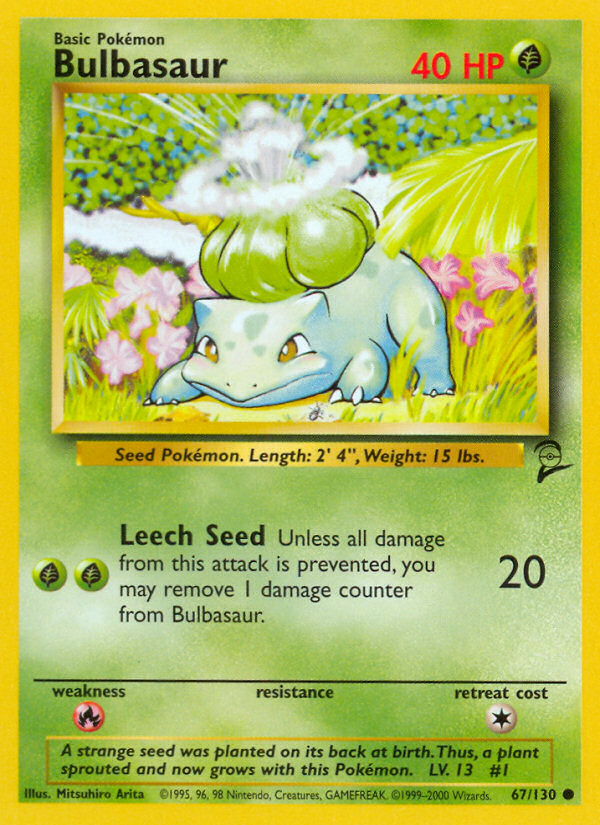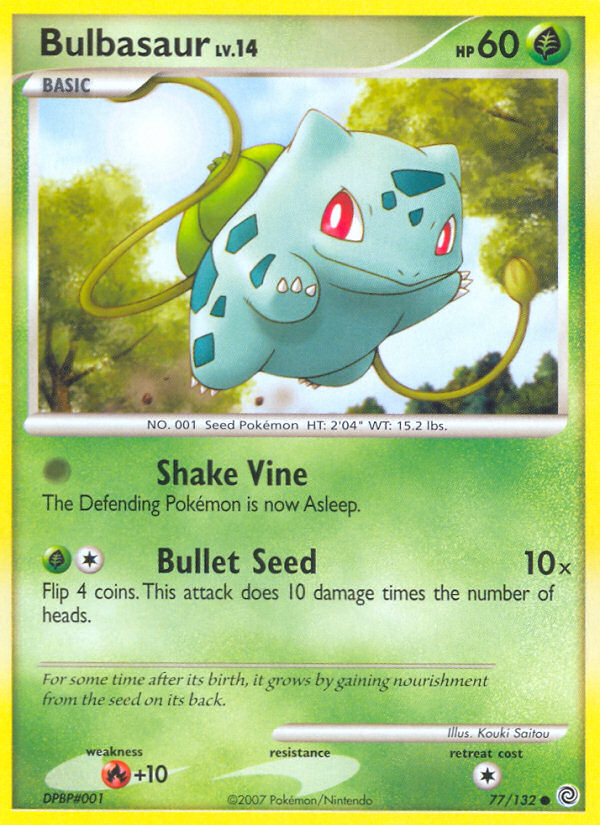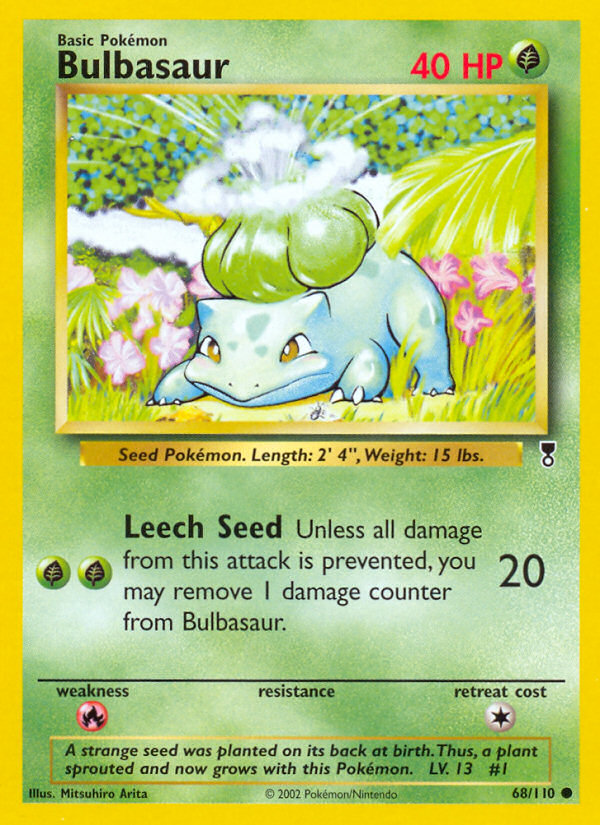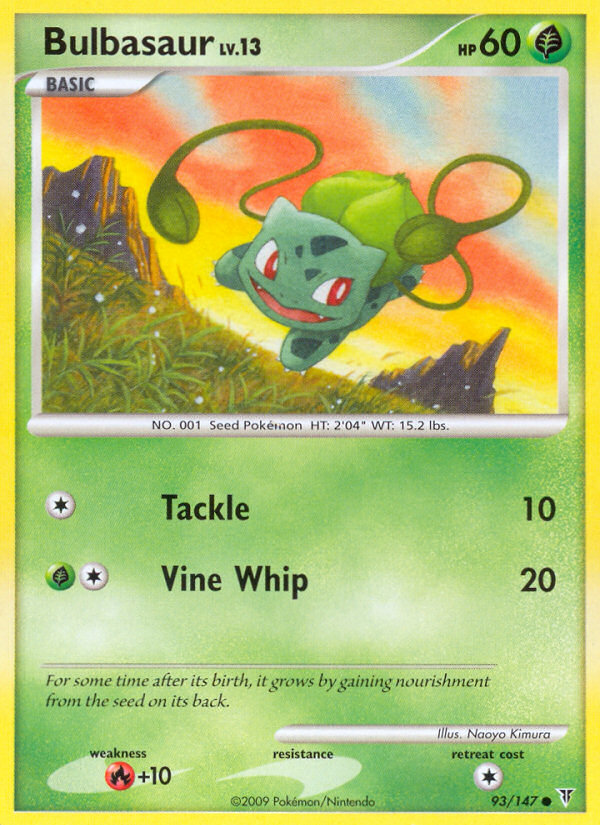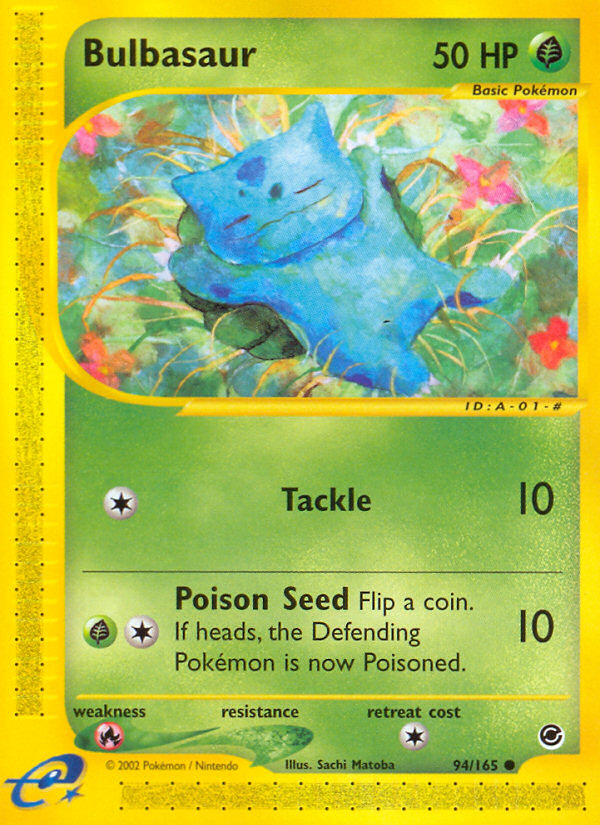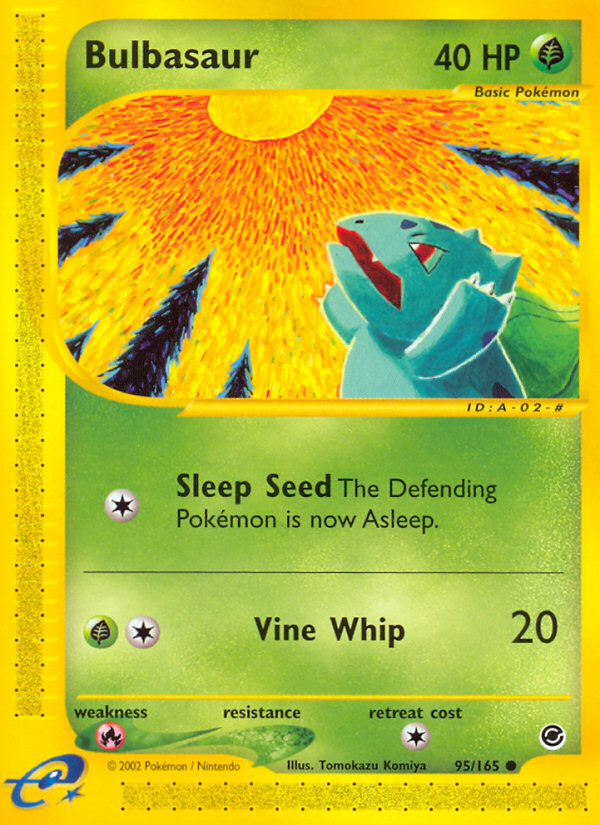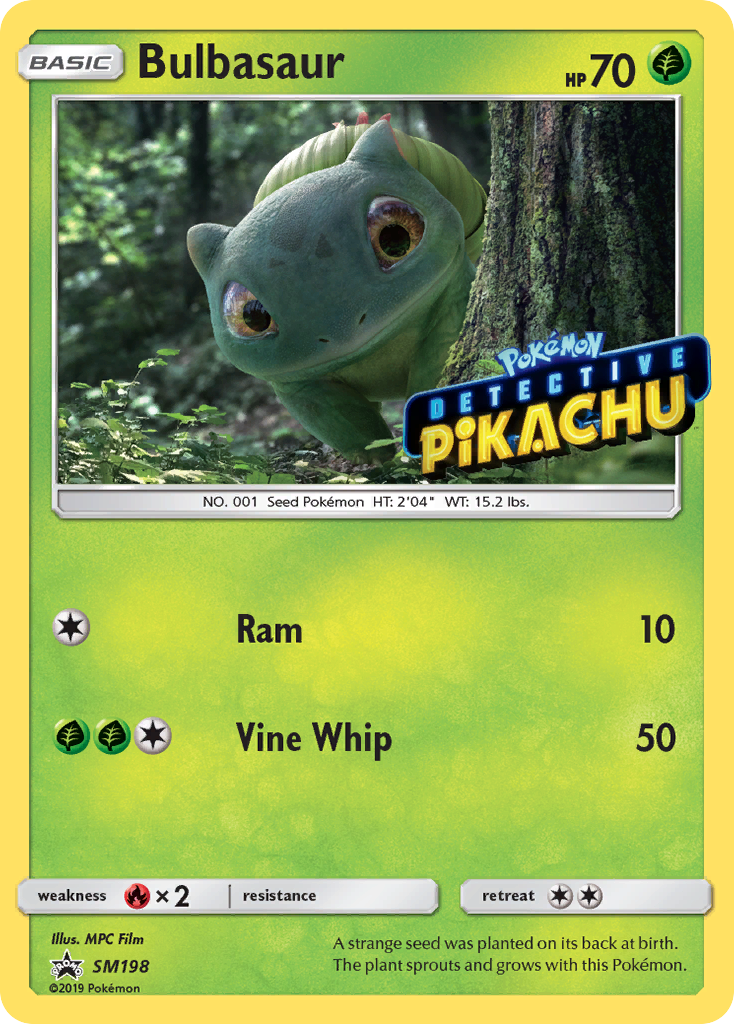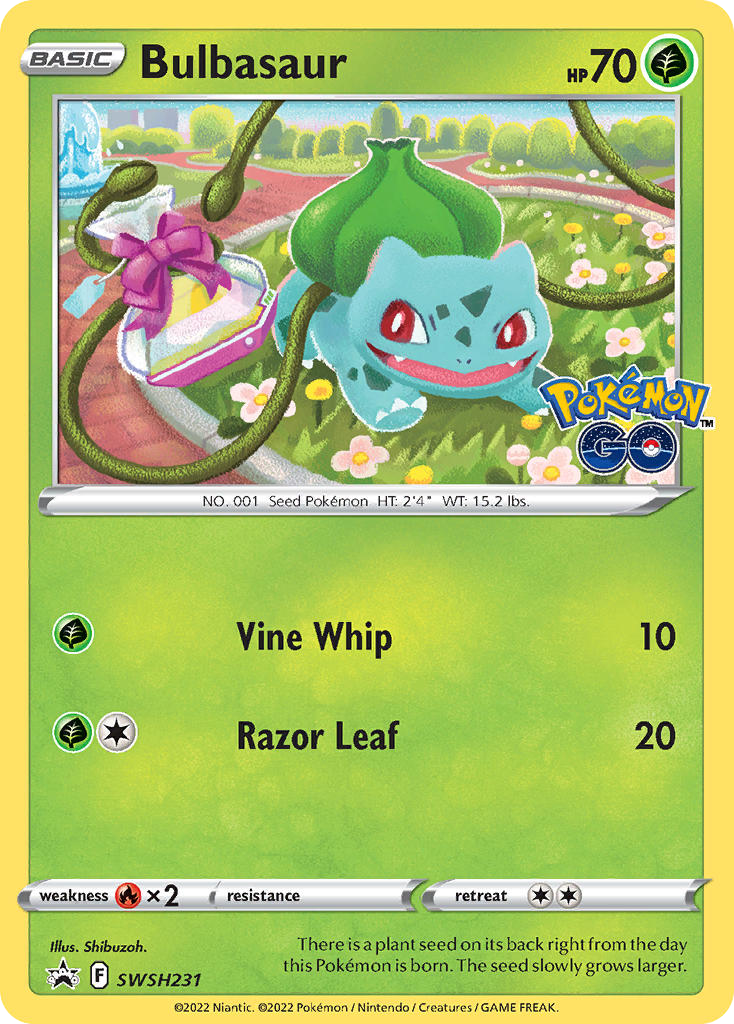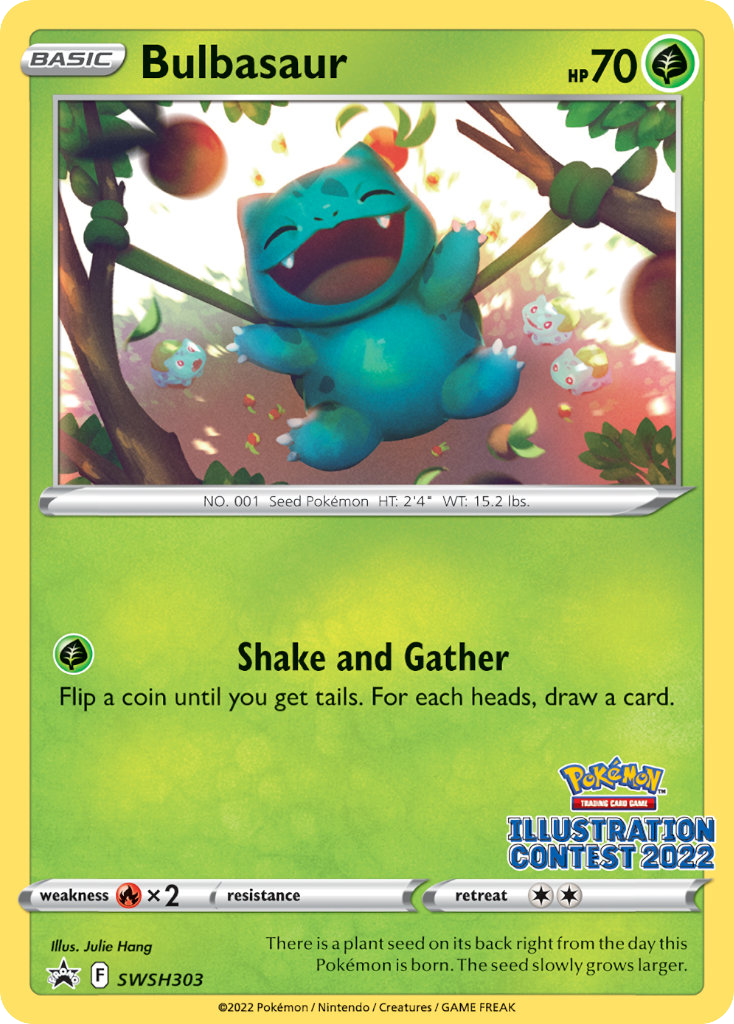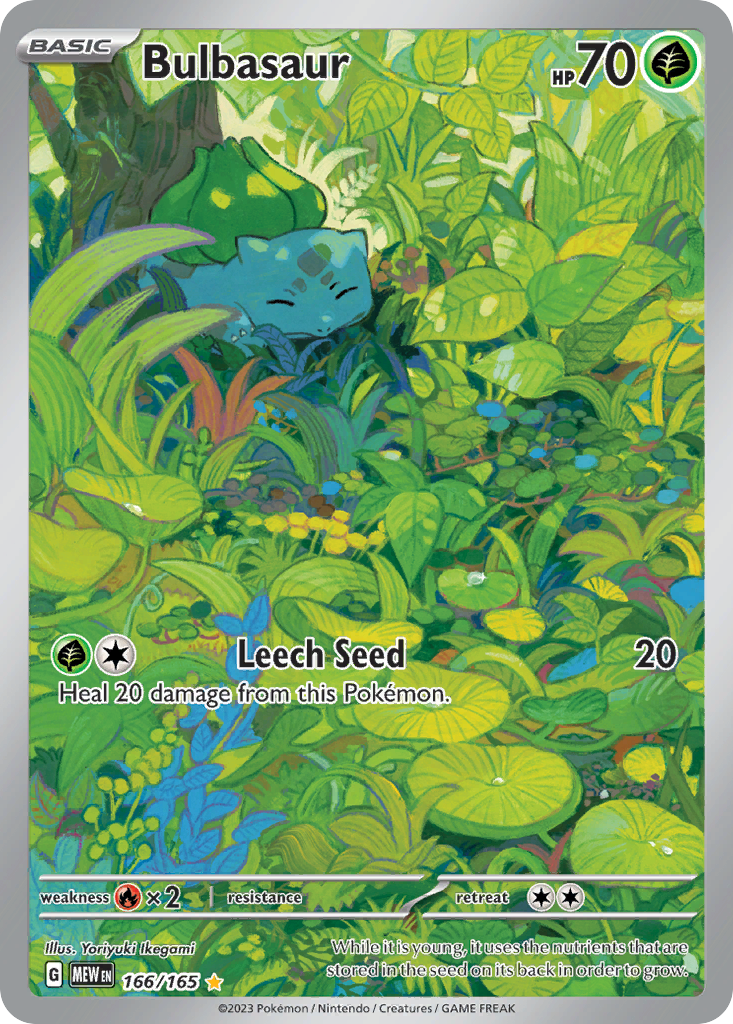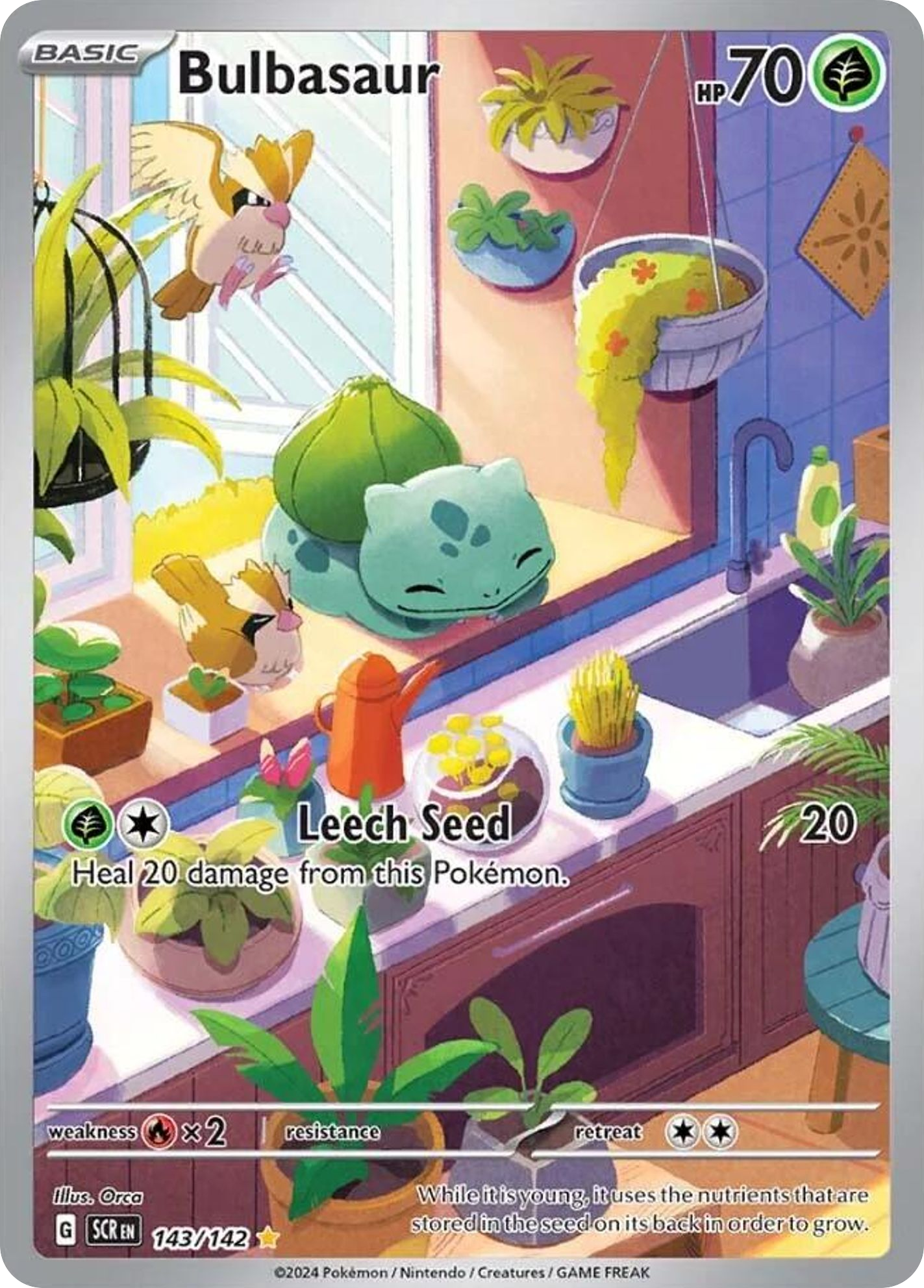Bulbasaur
Seed Pokémon #1- 45HP
- 49Attack
- 49Defense
- 65S-Atk
- 65S-Def
- 45Speed
Pokédex • Pokémon #1 • Bulbasaur
Pokémon Description
There is a plant seed on its back right from the day this Pokémon is born. The seed slowly grows larger.
While it is young, it uses the nutrients that are stored in the seed on its back in order to grow.
Evolutions
Pokémon Details
- Height2' 4''
- Weight15.2 lbs.
- GenderMale or Female
- HabitatGrassland
Abilities
OvergrowWhen this Pokémon has 1/3 or less of its HP remaining, its grass-type moves inflict 1.5× as much regular damage.
Hidden Abilities
ChlorophyllThis Pokémon's Speed is doubled during strong sunlight. This bonus does not count as a stat modifier.
Cards Like Bulbasaur
Storyline
Bulbasaur’s earliest anime appearance shows it living in a hidden village of injured Pokémon. In the episode Bulbasaur and the Hidden Village, it watches over a forest clearing and tackles Misty when she reaches for an Oddish, choosing to trust no trainer rather than risk its wards. When Team Rocket tries to vacuum up the forest Pokémon, Bulbasaur flicks its vines into the cyclone and pulls Oddish free, then joins Ash and Pidgeotto to send the villains flying; afterwards it accepts Ash as its new partner only after a respectful battle where Pikachu proves its mettle1. The scene establishes Bulbasaur as a protector who acts decisively yet weighs loyalty before offering it.
Later, in the episode Bulbasaur’s Mysterious Garden, Ash’s Bulbasaur attends a secret evolution ceremony led by Venusaur. When the Ivysaur begin to glow, Bulbasaur refuses to evolve and shakes its head at the urging of the elders. Team Rocket interrupts the ritual and traps the Ivysaur, but Bulbasaur learns Solar Beam on the spot, charges sunlight through its bulb and blasts the cage apart; Venusaur, impressed, shakes vines with the little Pokémon, signifying mutual respect2. This anecdote shows Bulbasaur asserting autonomy while still protecting its peers.
In a later arc Professor Oak summons Bulbasaur to mediate disputes among two groups of Pokémon at his lab. The episode Bulbasaur… the Ambassador! has Bulbasaur step between a three‑way brawl and, when negotiation fails, fire a Solar Beam skyward to halt the fight; the other Pokémon fall silent and follow its plan to dig a new lake by coordinating Poliwhirl and Sandslash, then watch as it rescues an Oddish from a rolling boulder3. Bulbasaur chooses to stay at Oak’s lab to continue this caretaker role, showing how its protective instinct evolves into leadership.
Growth Life Cycle
Beginnings
Bulbasaur starts steady in early Kanto journeys and faces the light when it wakes. It keeps a low stance when streets get loud and watches the lane ahead before it moves. Bulbasaur lifts a vine to check range, then withdraws it as the bulb warms on a stone step. These small choices set a calm rhythm and point toward measured strength. In the Hidden Village, Bulbasaur guards injured Pokémon under Melanie’s care and blocks the path when intruders arrive; it plants its feet, absorbs the shove, and pushes the line back toward safety.1
Emerging Patterns
Bulbasaur plays for timing rather than speed. It places a seed to mark space, reads movement, and strikes when the opponent breaks pace. Midday practice often helps it charge and settle, and anchoring before action keeps exchanges clean. After a miss, Bulbasaur resets and attacks on the next count instead of rushing. During drills on a chalk line outside Cerulean, it holds center, taps once to draw a step, and lands the follow up when the lane opens.
Encounters
Bulbasaur faces a moonlit ceremony in the Mysterious Garden and begins to evolve while Ivysaur and a towering Venusaur look on. It stops when doubt rises, then chooses resolve over ritual after Team Rocket nets the gathering. At dawn, Bulbasaur gathers light, fires a new Solar Beam, and frees the captured Ivysaur while the balloon ruptures above the trees; the choice puts readiness above ceremony.2
Becomings
Bulbasaur turns patience into a finish when matches run long. Its Grass attacks hit harder late in battles when both sides tire, and clean timing breaks stalls that frustrate faster teams. A steady breath settles its frame, and one last step sets the angle for the strike that ends the exchange. Evolution follows when the same habits hold against stronger rivals. The identity arrives first: Bulbasaur measures space, protects the fragile point, and ends fights at the moment it chooses.
Training
Trainers who partner with Bulbasaur often note how its temperament shapes daily routines. It thrives under gentle guidance rather than strict drills: early mornings spent tending to its bulb in bright sunlight help it store energy for the day, a habit drawn from Pokédex notes that Bulbasaur can survive for days without eating by photosynthesizing through its bulb4. Regular sessions of vine exercises, such as having it hoist small logs or rock younger Pokémon to sleep, build strength while appealing to its nurturing instincts5. Feeding it at dusk reinforces its reliance on stored nutrients while keeping it engaged with its trainer.
Move selection during training reflects Bulbasaur’s supportive style. Guides advise teaching Leech Seed and Sleep Powder early because these moves allow it to chip away at tougher opponents while keeping them immobile, a safer strategy for a Pokémon that values the well‑being of its team6. Incorporating Sunny Day into drills prepares it for Solar Beam by reducing the usual charge time; in practice sessions this means waiting for the sun to peak before unleashing a powerful beam, echoing the quiet conviction seen in the Mysterious Garden scene. Trainers should avoid overloading Bulbasaur with offensive techniques: the Nuzlocke guide cautions that its movepool is shallow, so focusing on a few reliable moves preserves its confidence6.
Battle
In battle Bulbasaur treats the field like a garden to be tended rather than a stage for dominance. When facing Team Rocket’s machines in the hidden village and at the evolution ceremony, it uses its vines not to attack first but to rescue captive Pokémon12. It then positions itself to absorb sunlight and unleash Solar Beam at pivotal moments, clearing obstacles and freeing allies. This timing shows how Bulbasaur saves its power for when it will help the most rather than seeking to overwhelm foes.
Competitive analysts echo this support‑first approach. In Little Cup formats, Bulbasaur’s Overgrow ability boosts Giga Drain and Razor Leaf when its health dips, allowing it to recover while damaging opponents, and Chlorophyll doubles its speed under sunlight, letting it act as a mid‑battle pivot rather than a sweeper6. Trainers combine Leech Seed with Sleep Powder to stall, sap, and set up team members; this method mirrors Bulbasaur’s anime battles where it stalls opponents long enough for comrades to regroup. Even in card battles, its Detective Pikachu print offers an attack called “Find a Friend” that searches the deck for another compatible Pokémon, reflecting how Bulbasaur’s battle instincts revolve around supporting others7.
Behavior
Day‑to‑day, Bulbasaur balances work and rest in a way that reflects its pragmatic nature. Pokédex entries note that the bulb on its back absorbs sunlight, enabling it to go for days without eating4. It often naps in bright sunlit patches and wakes at dusk when temperatures cool, timing that helps it store energy and avoid predators. Bulbapedia remarks that Bulbasaur can climb trees using its vines, reaching berries that sustain both itself and companions5.
Bulbasaur displays a nurturing side around other Pokémon. In hidden villages it rocks crying Pokémon with its vines and guides injured friends to shady spots5. The ambassador episode highlights its habit of digging new habitats for others and rescuing those in danger3. These small choices, such as tucking an Oddish under a leaf or sharing a sunbeam, reveal a creature that sees care as action rather than sentiment.
Environment
Bulbasaur’s preferred habitats reflect its reliance on sunlight and moisture. Bulbapedia describes it as a rare Pokémon raised by breeders and then given to trainers, so wild sightings are uncommon, but when found it inhabits grasslands and forests near clearings where sunlight filters through5. It tends to sleep in sunny spots and can photosynthesize even while resting, making sun‑drenched riverbanks and meadows its ideal haunts4.
Communal gatherings take place in hidden gardens where Bulbasaur congregate for evolution ceremonies. When a bulb flashes blue, the community escorts that individual to a secluded glade so it can evolve without disturbance5. These secret spaces mirror the hidden village from its first anime appearance, emphasizing that even in the wild Bulbasaur builds structured communities away from the eyes of predators and opportunistic trainers.
Collector’s Guide
- 1999 Base Set Bulbasaur #44/102: First main‑set appearance and an icon of the original era. Early prints (including shadowless/1st‑print distinctions) and the starter‑Pokémon nostalgia keep demand high. In Japan, a contest reprint swapped in a player‑shot Pokémon Snap photo and a small camera stamp—an unusual, story‑driven variant tied to a magazine photo contest, coveted for its origin.
- 1999 CoroCoro Pokémon Snap Best Photo Contest (Japan): Five winning in‑game photos (including Bulbasaur) were turned into real cards, reportedly with just twenty copies per winner—distribution so tiny that provenance and condition dominate value conversations. The camera icon and “Best Photo Contest Winners” text signal its origin.
- 2002 Legendary Collection Reverse Holo #68/110: The set that introduced the dramatic “fireworks” reverse holo pattern. Bulbasaur’s reprint here is a condition‑sensitive favorite; the bold foil makes clean surfaces and centering matter, which fuels collector interest.
- 2019 Detective Pikachu #1/18: A film tie‑in with photoreal art and a deck‑smoothing “Find a Friend” attack. Cross‑media spotlight and theater‑era distribution give it broad appeal beyond core TCG fans.
- 2021 McDonald’s 25th Anniversary: Happy Meal‑only packs with a confetti holo pattern and a starter‑focused checklist. The promotion’s limited window, kid‑centric distribution, and 25th‑anniversary branding created an accessible but highly chased Bulbasaur for nostalgia sets.
Note: This guide avoids pricing. It explains why certain prints are sought after—scarcity, cultural moments, and condition sensitivity.
Sources
- 1 Serebii.net – Episode Guide: Bulbasaur and the Hidden Village ↗
- 2 Fandom.com – Ash’s Bulbasaur ↗
- 3 Bulbapedia.bulbagarden.net – Bulbasaur… the Ambassador! ↗
- 4 Pokemon.database – Pokémon Database: Bulbasaur Pokédex entries ↗
- 5 Bulbapedia.bulbagarden.net – Bulbasaur (Pokémon) ↗
- 6 Nuzlockeuniversity.ca – A Nuzlocker’s Guide to the Bulbasaur Line ↗
- 7 Pokemon.com – Pokémon TCG card database ↗
- 8 Bulbapedia.bulbagarden.net – Bulbasaur (Base Set 44) ↗
- 9 PokeGuardian.com – Pokémon 25th Anniversary McDonald’s set ↗
- 10 Collectibles.com – 2002 Legendary Collection Bulbasaur reverse holo ↗
- 11 Sportscardinvestor.com – Bulbasaur card price guide ↗

